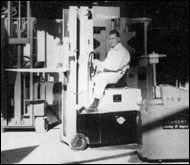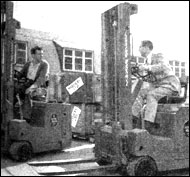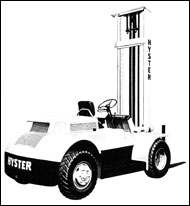 During October 1959, the Paris International Handling Exhibition was held at the C.N.I.T. (National Centre of Industries and Techniques). More than 400 companies were represented, with some British manufacturers showing equipment in most of the sections. Among the materials handling machinery directly imported from Britain were forklift trucks and lifting equipment by Conveyancer, Collis and Slingsby. Representing Lansing Bagnall was Jeumont, who manufactured part of the Lansing range under licence. The main interest here was the prototype FOER 1, designed in France and loosely based on the Lansing Bagnall model PFTC.
During October 1959, the Paris International Handling Exhibition was held at the C.N.I.T. (National Centre of Industries and Techniques). More than 400 companies were represented, with some British manufacturers showing equipment in most of the sections. Among the materials handling machinery directly imported from Britain were forklift trucks and lifting equipment by Conveyancer, Collis and Slingsby. Representing Lansing Bagnall was Jeumont, who manufactured part of the Lansing range under licence. The main interest here was the prototype FOER 1, designed in France and loosely based on the Lansing Bagnall model PFTC.
Another of the company’s products that was featured at this time was the Lansing model FOER 3 in a trade union film satire called ‘I’m alright Jack,’ now a comedy classic. The efficiency and speed of this truck, in a missiles factory, was used as a tool both by a corrupt management and a stubborn union. The outcome was a workers’ strike, which eventually led to a national strike and the near economic collapse of the country. The actors Peter Sellers, Ian Carmichael and Terry Thomas were among those starring in the film.
 Elsewhere in France, in the town of Arcensis, a new company was in the process of marketing an all-terrain forklift truck. The company of Braud and Faucheux, primarily producing cement mixers and small cranes for the construction industry, had moved into materials handling.
Elsewhere in France, in the town of Arcensis, a new company was in the process of marketing an all-terrain forklift truck. The company of Braud and Faucheux, primarily producing cement mixers and small cranes for the construction industry, had moved into materials handling.
The first model, the MC 5, was built using a four-wheeled McCormick tractor as its base, and incorporated Marcel Braud’s own design motorized forklift attachment. This was also the company’s first production machine to carry the name ‘Manitou’. To those not acquainted with French grammar, the word Manitou was a shortening and melding of the French words to ‘handle’ and ‘all.’
Meanwhile over the border in Germany the rapidly growing company of Sichelschmidt begins production of their new forklift model the Mucke 7. This machine also had a three-wheel configuration but, unlike the Manitou, was battery powered.
 The big news from America at this time was an announcement from the Hyster Company that they had launched four new trucks in their Challenger series. The first two replaced, although not directly, the RT100 and RT120 in the Spacesaver series. Both new trucks were said to be the first forklift trucks to be specifically designed for 10,000 lbs and 12,000 lbs capacities, and were designated H100B and H120B respectively. When fitted with the dual range power-shift ‘Hystamatic’ transmission, they had the advantage of fast direction control and left foot inching, whilst the right foot could maintain engine speed for quick lifting. The gasoline-powered six-cylinder F244 ‘Continental’ engine was used on both ‘Hystamatic’ and manual options. When coupled to the manual three speed synchronized transmission, a clutch made from a ceramic compound was available. This, it was claimed, could withstand a temperature of 1,200 degrees Fahrenheit.
The big news from America at this time was an announcement from the Hyster Company that they had launched four new trucks in their Challenger series. The first two replaced, although not directly, the RT100 and RT120 in the Spacesaver series. Both new trucks were said to be the first forklift trucks to be specifically designed for 10,000 lbs and 12,000 lbs capacities, and were designated H100B and H120B respectively. When fitted with the dual range power-shift ‘Hystamatic’ transmission, they had the advantage of fast direction control and left foot inching, whilst the right foot could maintain engine speed for quick lifting. The gasoline-powered six-cylinder F244 ‘Continental’ engine was used on both ‘Hystamatic’ and manual options. When coupled to the manual three speed synchronized transmission, a clutch made from a ceramic compound was available. This, it was claimed, could withstand a temperature of 1,200 degrees Fahrenheit.
The other two trucks in this series were the forklift truck models H360A and H400A, designed to lift 36,000 lbs and 40,000 lbs respectively. These machines would later be known as part of the ‘big truck’ range and had a choice of ‘Continental or Detroit engines in gasoline or diesel options.
By James Brindley, Director, National Fork Truck Heritage Centre
To be continued




Comments are closed.